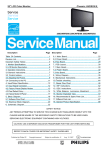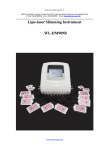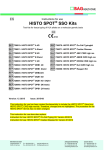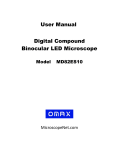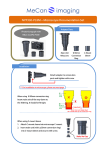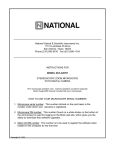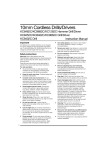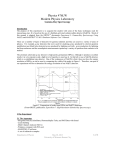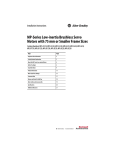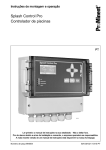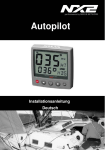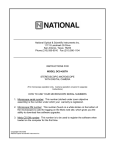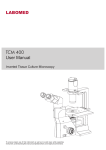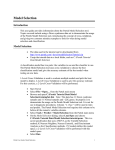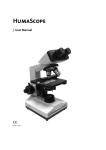Download User Manual Trinocular Stereo Microscope
Transcript
User Manual Trinocular Stereo Microscope V434 Model XV434 Series MicroscopeNet.com Table of Contents i. Caution……..……………………………………………………………1 ii. Care and Maintenance……….………………………………….….…2 1. Component Illustration………………………….…………………..…3 2. Installation………………………………………………………………4 3. Operation ….…………………………………………………………...6 4. Specifications…………………….………………………………….....8 5. Troubleshooting Guide....................................................................9 6. Optional Parts…………………………………………………………10 www.microscopenet.com i. Caution 1. Find the “UP” sign and place the Styrofoam container on your table or bench so that the arrow is pointing upward. Open the shipping carton carefully to prevent any accessory, like eyepieces, from dropping and being damaged. 2. Do not discard the molded Styrofoam container. The container should be retained should the microscope ever requires reshipment. 3. Keep the instrument out of direct sunlight, high temperature or humidity, and dusty environments. Ensure that the microscope is located on a smooth, level and firm surface. 4. If any specimen solutions or other liquids splash onto the stage, objective or any other component, disconnect the power cord immediately and wipe up the spillage. Otherwise, the instrument may be damaged. 5. Important: the lamp, lamp housing and adjacent parts will become very hot. Do not touch these parts until they have completely cooled. Never attempt to handle a hot halogen bulb. 6. All electrical connectors (power cord) should be inserted into an electrical surge suppressor to prevent damage due to voltage fluctuations. 7. For safety when replacing the halogen lamp or fuse, be sure the main switch is off, unplug the power cord, and only replace the halogen bulb after the bulb and the lamp house has completely cooled. 8. Confirm that the input voltage indicated on your microscope corresponds to your line voltage. The use of a different input voltage other than that as indicated will cause severe damage to the microscope. -1- www.microscopenet.com ii. Care and Maintenance 1. Do not attempt to disassemble any component including eyepieces, objectives or focusing mechanism. 2. Keep the instrument clean; remove dirt and debris regularly. Accumulated dirt on metal surfaces should be cleaned with a damp cloth. More persistent dirt should be removed using a mild soap solution. Do not use organic solvents for cleansing. 3. The outer surface of the optics should be inspected and cleaned periodically using an air stream from an air bulb. If dirt remains on the optical surface, use a soft cloth or cotton swab dampened with a lens cleaning solution (available at camera stores). All optical lenses should be swabbed using a circular motion. A small amount of absorbent cotton wound on the end of a tapered stick makes a useful tool for cleaning recessed optical surfaces. Avoid using an excessive amount of solvents as this may cause problems with optical coatings or cemented optics or the flowing solvent may pick up grease making cleaning more difficult. 4. Store the instrument in a cool, dry environment. Cover the microscope with the dust cover when not in use. -2- www.microscopenet.com 1 Components Illustration 1 11 2 12 3 13 4 14 5 15 6 16 7 17 8 18 9 19 10 20 21 1 2 3 4 5 6 7 Photo Tube Stand Post Trinocular Body Eyepiece/Photo Switch Thumb Screw Focus Knob Focus Block 8 9 10 11 12 13 14 Post Collar Incident Light Intensity Dial Transmitted Light Intensity Dial Eyepiece Diopter Ring Eyepiece Tube Zoom Knob -3- 15 16 17 18 19 20 21 Holding Ring Objective Housing Incident Light Power Switch Stage Clip Stage Plate Base www.microscopenet.com 2 Installation 2.1 Install the microscope body 2.1.1 Loosen the thumb screw on the body holding ring. 2.1.2 Sit the body into the holding ring firmly. 2.1.3 Tighten the thumb screw. Thumb Screw Holding Ring 2.2 Install the eyepieces 2.2.1 Take off the plastic covers on the eyepiece tubes. 2.2.2 Insert the eyepieces into the eyepiece tubes. 2.3 Adjust the focus block 2.3.1 Loosen the knob on the focus block. 2.3.2 Slide the focus block up or down on the stand post so that the distance between the bottom of the objective housing and the Post Collar stage plate is about 95mm (with no auxiliary lens) or 150mm (with 0.5X auxiliary lens on). And then tighten the knob. 2.3.3 Slide the post collar to against the focus block as showed in the figure, and then tighten its knob. 2.4 Replace the incident light bulb 2.4.1 Turn the power off and disconnect the power cord. 2.4.2 Allow some time to cool down the lamp. 2.4.3 Take off the black light housing by turning it counterclockwise. 2.4.4 Pull the bulb (with reflector) out gently. 2.4.5 Align the two pins of the bulb with the sockets then press the light bulb gently in. 2.4.6 Put the light housing on and tighten by turning it clockwise. Light Bulb Light Housing 2.5 Replace the transmitted light bulb 2.5.1 Turn the power off and disconnect the power cord. 2.5.2 Allow some time to cool down the lamp. 2.5.3 Turn over the microscope on its side; find the light compartment at the bottom. 2.5.4 Open the cover of the compartment by loosening the screw. 2.5.5 Take out the dead bulb and insert the new bulb. Be sure the pins on the bulb are completely inserted into the lamp socket. 2.5.6 Put the cover back and tighten the screw. Screw Light Bulb Light Compartment -4- www.microscopenet.com 2.6 Replace the fuse 2.6.1 Pry out the fuse holder with a screw driver. 2.6.2 Install / replace the fuse. 2.6.3 Insert the fuse holder back to its place. Fuse Holder 2.7 Install the auxiliary lens (optional) 2.7.1 Screw off the plastic cover on the bottom of objective housing. 2.7.2 Screw on the auxiliary lens onto the objective housing. Note: The auxiliary lens is optional and may have different color and shape from the one in the picture, depends on the model purchased. 2.8 Install the camera (optional) 2.8.1 Take off the plastic cover on the phototube. 2.8.2 Insert the camera into the phototube, and then connect the camera to a computer by a USB cable. 2.8.3 Refer to the manual in the Camera CD to installation the driver and software. Note: The camera is optional and may have different color and shape from the one in the picture, depends on the model purchased. Auxiliary Lens Camera Photo Tube 2.9 Install the ring light (optional) 2.9.1 Screw off the plastic cover on the bottom of objective housing. 2.9.2 Screw on the ring light adapter onto the objective housing. 2.9.3 Put the ring light on to the ring light adapter. Tighten the 3 screws. Make sure the end of the screws stick into the groove of the adapter. Note: The ring light is optional and may have different color and shape from the one in the picture, depends on the model purchased. Ring Light Ring Light Adapter -5- www.microscopenet.com 3 Operation 3.1 Change the stage plate 3.1.1 Loosen the stage lock screw at the front of base. 3.1.2 Take off the glass plate and put on the white/black plate (or vice versa). 3.1.3 Tighten the set screw. Thumb Screw 3.2 Place the specimen 3.2.1 Put the specimen in the center of the stage plate. 3.2.2 Hold the specimen with the stage clips if necessary. 3.3 Focusing 3.3.1 Turn the zoom knob at 0.7. 3.3.2 Turn the focus knob until the specimen is in focus. 3.3.3 Move the interesting spot of specimen into the center of field of view. 3.3.4 Turn the zoom knob for the desired magnification. 3.3.5 Adjust the focus knob slightly to get clear image. 3.4 Adjusting interpupillary distance While observing with both eyes, hold the left and right eyepiece tubes and swing inwards or outwards. The interpupillary distance is correct when the left and right fields of view converge completely into one image. 3.5 Adjusting eyepiece diopter 3.5.1 Turn the diopter rings on both eyepiece tubes at 0 positions. 3.5.2 Using your right eye only, observe your specimen through the right eyepiece and bring it into focus by adjusting the focus knob. 3.5.3 Then observe the specimen with your left eye only through the left eyepiece. If the specimen is not in focus, rotate the diopter ring until a sharp image is obtained. 3.6 Adjust the light 3.6.1 Plug in the power cord to a power outlet. 3.6.2 Turn the switch to the “I” position to turn on the power. 3.6.3 Turn the switch to the “O” position to turn off the power. 3.6.4 Turn the incident light intensity dial to turn the incident light on and adjust the intensity. 3.6.5 Turn the transmitted light intensity dial to turn the transmitted light on and adjust the intensity. 3.7 Adjust the ring light (optional) 3.7.1 Install the ring light, and connect the AC adapter to the power outlet. 3.7.2 Turn on the power button on the ring light. 3.7.3 Adjust the intensity dial. -6- Power Switch www.microscopenet.com 3.8 Camera (optional) 3.8.1 Install the camera following the procedures in 2.8. 3.8.2 Focus the microscope following the procedures in 3.3. 3.8.3 Pull out the switch bar. 3.8.4 Open the software of the camera and launch the live view window. 3.8.5 If the live view image is not in focus, loosen the thumb screw showed in the right figure, turn the plastic part of the photo tube to adjust the photo tube height till the image is in focus, then tighten the thumb screw. 3.8.6 You can observe image, snap picture, and capture video in the software. Note1: Please refer to the User Manual in the Camera CD for the software operation. Note2: The camera is optional and may have different color and shape from the one in the picture, depends on the model purchased. -7- Plastic Part Thumb Switch Bar www.microscopenet.com 4 Specifications Model V434/XV434 Series Microscope body Trinocular, 45º inclined, 360º swiveling. Adjustable Interpupillary distance 55 ~ 75mm (2-3/16” ~ 2-15/16”) Adjustable diopter on both eyepiece tube ±5dp Eyepieces 1 pair of WF10X 1 pair of WF20X (optional) Objectives Zoom 0.7x ~ 4.5x, ratio 6.5:1 Auxiliary lens 0.5X (optional) Focusing Mechanism Rack and pinion, focusing knobs on both sides Working Distance 95 mm (3-3/4”) 152 mm (6”) with 0.5X auxiliary lens on Stage Plate Frosted glass plate: 95mm (3-3/4”) in diameter White/black plastic plate: 95mm (3-3/4”) in diameter Illumination Incident (upper): 12V/10W halogen light Transmitted (lower): 12V/10W halogen light With switch and intensity dials separately Power Supply Microscope: AC 110V – 240V, 50/60Hz Dimension 23cm x 16cm x 44cm (9” x 6” x 17-1/2”) Net weight 6 kg (13 lb) -8- www.microscopenet.com 5 Troubleshooting Guide Symptom Totally dark in the view field Cause Remedy The cover of objectives is still on Take off the cover of objectives Stains or dust on the eyepieces or objectives Clean the lens with a camera cleaning kit Stains or dust on the specimen Clean the specimen Can not focus The focus block/objectives is too far away or too close to the specimen and out of the range of focus stroke Adjust the height of the focusing mechanism so that the distance between the objectives and specimen is about 95mm (with no auxiliary lens) or 152mm (with 0.5X auxiliary lens on). Image moves while focusing Specimen rises from stage surface Secure the specimen No electrical power Check power cord connection Lamp bulb burnt out Replace bulb Fuse blown out Replace fuse Stains or dust on the field of view Lamp does not light when switched on -9- www.microscopenet.com 6 Optional Parts (The optional parts may be included in some models or sold separately.) 6.1.1 Camera Model Resolution A1502 640 x 480 (0.3MP) A1510 1280 x 1024 (1.3MP) A1520C 1600 x 1200 (2.0MP) A1530 2048 x 1536 (3.0MP) A1550 2592 x 1944 (5.0MP) A1590 3488 x 2616 (9.0MP) Operating System Software MS Windows (32/64bit) Included MS Windows (32bit) MS Windows (32/64bit) 6.1.2 Illuminator Model Lamp A12CR Halogen 21V/150W Fiber Cold Ring Light A12CY Halogen 21V/150W Fiber Cold Y Light A9208 8W Fluorescent Ring Light A9212 128W Fluorescent Ring Light A9239 39 LEDs Macro Ring Light A9254 A9254P 54 LEDs Macro Ring Light A9264S 64 LEDs Macro Ring Light A92144B 144 LEDs Macro Ring Light A92144L 144 LEDs Macro Ring Light A92144S 144 LEDs Macro Ring Light 6.1.3 Auxiliary Objective Lens Model Magnification AJ5D3AUX 0.3X AJ5D5AUX 0.5X AJ5D75AUX 0.75X AJ5X2 0.2X - 10 -












